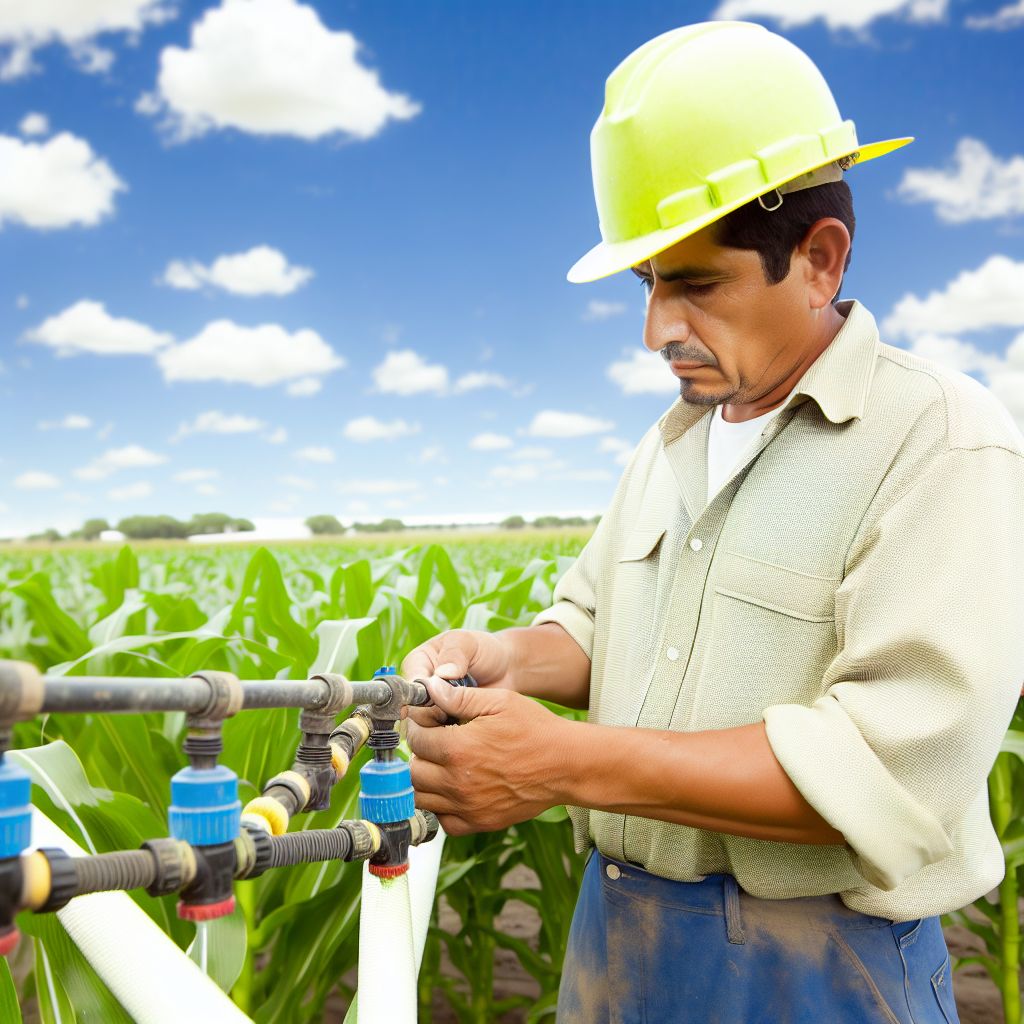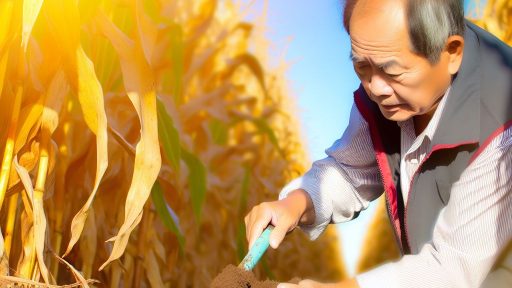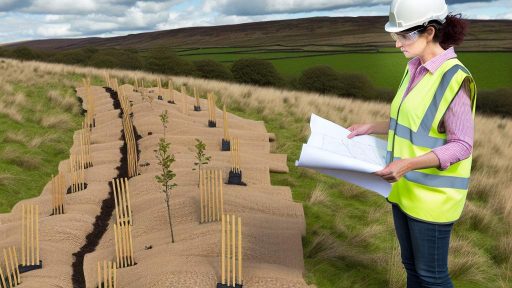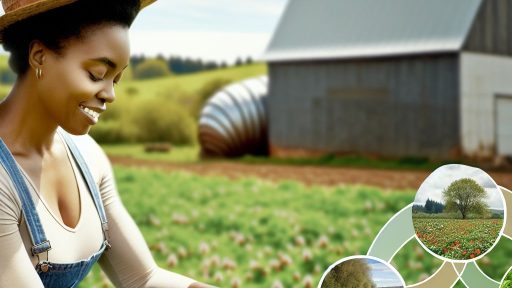Introduction to Water Conservation in Agriculture
Water conservation plays a vital role in sustainable agriculture.
Farmers face increasing challenges due to climate change and water scarcity.
Consequently, efficient water management is essential for crop productivity.
Importance of Water Conservation
Water conservation helps maintain viable agricultural practices.
It reduces the risk of drought, thus safeguarding food security.
Additionally, it minimizes the environmental impact of farming activities.
Benefits of Effective Water Management
Implementing water conservation techniques offers many advantages.
- Increased crop yields through optimized irrigation.
- Reduced water costs for farmers.
- Enhanced resilience against climate variability.
Farmers who adopt these methods see long-term sustainability.
Techniques for Water Conservation
Several techniques exist that promote water conservation effectively.
- Drip irrigation delivers precise amounts of water directly to roots.
- Rainwater harvesting captures and stores rain for future use.
- Soil moisture management techniques, like mulching, enhance water retention.
These techniques ensure water is used efficiently across agricultural sectors.
Challenges Facing Water Conservation Efforts
Despite its importance, water conservation faces several challenges.
Modern agriculture often prioritizes short-term gains over sustainable practices.
Moreover, limited funding for innovative technologies hinders adoption.
Awareness and education are crucial for overcoming these barriers.
Importance of Water Conservation for Sustainable Farming
Essential Resource for Agriculture
Water is a fundamental resource for agriculture.
Transform Your Agribusiness
Unlock your farm's potential with expert advice tailored to your needs. Get actionable steps that drive real results.
Get StartedWithout sufficient water, crops cannot thrive.
Farmers rely on water for irrigation and livestock needs.
As such, conserving this resource is crucial.
Impact on Crop Yield
Effective water conservation improves crop yield.
Farmers can grow more with less water through efficient methods.
Higher productivity leads to better economic outcomes for farmers.
Environmental Benefits
Water conservation protects ecosystems and natural habitats.
It reduces the risk of soil erosion and water pollution.
Consequently, healthier ecosystems support more diverse wildlife.
Adaptation to Climate Change
Climate change presents challenges to water availability.
Conservative practices help farmers adapt to varying weather conditions.
Using less water can ensure farming sustainability in the long run.
Economic Advantages
Water conservation reduces operational costs for farmers.
Savings on water bills can significantly improve profits.
Efficient water use also enhances land value over time.
Community and Social Impact
Water conservation fosters community resilience.
Collective efforts can lead to sustainable practices across regions.
Local engagement in conservation initiatives strengthens social ties.
Overview of Water Scarcity and Its Impact on Farming
Water scarcity presents a significant challenge in agriculture today.
This issue affects crop yields and farmer livelihoods across the globe.
More than two billion people currently live in water-stressed areas.
As climate change escalates, this threat is projected to worsen.
Understanding Water Scarcity
Water scarcity arises from several interrelated factors.
Firstly, population growth increases demand for freshwater resources.
Showcase Your Farming Business
Publish your professional farming services profile on our blog for a one-time fee of $200 and reach a dedicated audience of farmers and agribusiness owners.
Publish Your ProfileMoreover, inefficiencies in water management exacerbate the problem.
As a result, many regions face severe environmental degradation.
The Economic Impact on Farmers
Agricultural water shortages significantly impact farm profitability.
Farmers often struggle with inconsistent crop production due to this issue.
Consequently, food prices may rise, affecting consumers worldwide.
In addition, limited water access can lead to increased competition among farmers.
Future Consequences of Water Scarcity
If trends continue, global food security might be at risk.
Farmers may need to adapt quickly to changing water availability.
This adaptation could involve switching to drought-resistant crops.
Furthermore, agricultural practices will need to prioritize water efficiency.
See Related Content: Why Sustainable Irrigation Is Essential for Long-Term Land Investment
Techniques for Efficient Irrigation Systems
Drip Irrigation
Drip irrigation delivers water directly to the plant roots.
This method significantly reduces water waste.
Farmers can adjust the flow rate according to plant needs.
Furthermore, it minimizes weed growth by limiting water to non-crop areas.
Smart Irrigation Systems
Smart irrigation systems utilize technology for optimized water usage.
These systems monitor soil moisture levels continuously.
They adjust irrigation schedules accordingly to conserve water.
Additionally, they can integrate weather forecasts to prevent overwatering.
Rainwater Harvesting
Rainwater harvesting captures and stores rain for irrigation.
This technique utilizes natural rainfall, reducing dependence on groundwater.
Farmers can use various collection systems, including tanks and barrels.
Moreover, this method promotes sustainable water management on farms.
Soil Moisture Sensors
Soil moisture sensors help farmers monitor water levels efficiently.
These sensors provide real-time data on soil hydration.
As a result, they enable more precise irrigation decisions.
Consequently, this approach limits water usage and enhances crop health.
Contour Farming
Contour farming aligns crops with the land’s natural contours.
This practice reduces soil erosion and water runoff significantly.
Additionally, it helps retain moisture in the soil.
Farmers can achieve sustainable yields while conserving water resources.
Crop Selection
Choosing drought-resistant crops is a smart water conservation technique.
Such crops often require less water to thrive.
Farmers can adapt their planting strategies based on local climate conditions.
Moreover, this selection promotes resilience against droughts.
Explore Further: Climate Change Regulations Affecting Agricultural Real Estate Buyers
Implementing Rainwater Harvesting Methods
Understanding Rainwater Harvesting
Rainwater harvesting captures and stores rainwater for later use.
This method provides an effective solution to water scarcity.
Moreover, it reduces dependence on traditional water sources.
Farmers can utilize this technique for irrigation and livestock needs.
Showcase Your Farming Business
Publish your professional farming services profile on our blog for a one-time fee of $200 and reach a dedicated audience of farmers and agribusiness owners.
Publish Your ProfileBenefits of Rainwater Harvesting
This approach promotes sustainable agricultural practices.
Additionally, it helps reduce water bills for farm operations.
Harvesting rainwater improves the farm’s resilience to drought.
It also enhances local groundwater levels over time.
Designing a Rainwater Harvesting System
Begin with planning the layout of your collection system.
First, identify the catchment area’s size and location.
Next, select appropriate storage tanks for efficiency.
Consider using materials that prevent contamination of stored water.
Collecting Rainwater Effectively
Install gutters and downspouts to direct rainwater flow.
Ensure that these systems are regularly cleaned and maintained.
Incorporate leaf screens to filter debris effectively.
Additionally, use first flush systems to minimize pollutants.
Maintaining Your Rainwater Harvesting System
Regular maintenance ensures long-term efficiency.
Inspect tanks for leaks and sediment buildup routinely.
Also, check filters and screens for clogging.
Doing so will extend the lifespan of your system significantly.
Utilizing Harvested Rainwater
Integrate harvested rainwater into your irrigation system.
This reduces the need for municipal or well water.
Farmers can use it for watering crops and livestock.
It is crucial to monitor water quality before usage.
You Might Also Like: Water-Saving Irrigation Techniques for Sustainable Agricultural Growth
Soil Moisture Management Strategies
Importance of Soil Moisture
Soyl moisture is critical for healthy crops.
It influences plant growth and overall yield.
Moreover, balanced moisture reduces stress on plants.
Monitoring Soil Moisture Levels
Regularly monitor soil moisture to optimize irrigation.
Use moisture sensors for precise readings.
Additionally, soil moisture meters can help detect dryness.
Irrigation Techniques
Consider drip irrigation to conserve water effectively.
This method delivers water directly to plant roots.
Additionally, it minimizes evaporation and runoff.
Rainwater Harvesting
Implement rainwater harvesting to collect natural rainfall.
Use gutters and barrels to store excess water.
Furthermore, this technique promotes sustainability on farms.
Soil Amendments
Improve soil quality with organic matter like compost.
Organic matter enhances water retention in the soil.
Incorporating mulch also helps reduce evaporation.
Crop Selection
Choose drought-resistant crops for arid regions.
These crops require less water and thrive under stress.
Additionally, they can improve overall farm resilience.
Cover Cropping
Utilize cover crops to protect soil moisture during off-seasons.
Showcase Your Farming Business
Publish your professional farming services profile on our blog for a one-time fee of $200 and reach a dedicated audience of farmers and agribusiness owners.
Publish Your ProfileThese plants prevent soil erosion and increase organic matter.
Moreover, they help retain moisture in the soil.
Soil Conservation Techniques
Adopt practices like no-till farming to protect soil structure.
No-till techniques minimize soil disturbance and preserve moisture.
Additionally, contour farming can reduce runoff and erosion.
You Might Also Like: Biodiversity Benefits of Integrating Agroforestry in Rural Properties
Drip Irrigation vs. Traditional Irrigation: Pros and Cons
Understanding Drip Irrigation
Drip irrigation delivers water directly to the plant roots.
This method reduces water waste significantly.
It minimizes evaporation and runoff effectively.
Farmers can adjust water flow to meet plant needs.
Drip systems can be automated for efficiency.
As a result, labor costs may decrease over time.
Benefits of Drip Irrigation
First, drip irrigation improves crop yields through precise water delivery.
Second, it conserves water, making it ideal for arid regions.
Moreover, it lowers the risk of disease by keeping foliage dry.
Finally, it allows for fertigation, saving time and resources.
Drawbacks of Drip Irrigation
Drip irrigation systems can be expensive to install initially.
They require maintenance to prevent clogging and leaks.
Furthermore, they may not be suitable for all crop types.
Understanding Traditional Irrigation
Traditional irrigation involves using surface or overhead watering systems.
This method has been used for centuries in agriculture.
It often utilizes larger volumes of water than needed.
Farmers may face issues with runoff and evaporation.
Benefits of Traditional Irrigation
First, traditional systems are usually simpler and cheaper to install.
Second, they can cover large areas rapidly.
Moreover, they may be better for perennial crops needing consistent moisture.
Drawbacks of Traditional Irrigation
This system often leads to inefficient water use.
It can increase soil erosion due to excessive water flow.
Furthermore, it may contribute to disease spread among plants.
Choosing the Right Method
Farmers must weigh the pros and cons of each method carefully.
Assessing specific farm conditions is crucial.
Additionally, considering crop types plays an important role.
Budget constraints can also influence the final decision.
Finally, embracing technology may lead to better outcomes.

Use of Drought-Resistant Crop Varieties
Importance of Drought Resistance
Drought-resistant crops play a crucial role in sustainable agriculture.
They require less water, making them ideal for arid regions.
Farmers can maintain productivity even during dry spells.
Moreover, these crops reduce the need for irrigation.
Consequently, this conserves water resources essential for future use.
Types of Drought-Resistant Crops
Several crop varieties exhibit drought resistance traits.
Showcase Your Farming Business
Publish your professional farming services profile on our blog for a one-time fee of $200 and reach a dedicated audience of farmers and agribusiness owners.
Publish Your ProfileExamples include certain types of maize, sorghum, and millet.
Furthermore, legumes such as chickpeas and lentils are also resilient.
These crops can thrive on minimal moisture levels.
As a result, they reduce the risk of crop failure.
Benefits of Drought-Resistant Varieties
Drought-resistant varieties offer numerous advantages to farmers.
First, they increase crop yield under water-limited conditions.
Second, they are often bred for improved pest resistance.
This characteristic minimizes the need for chemical pesticides.
Additionally, these crops can enhance soil health through better root structure.
Implementing Drought-Resistant Techniques
Farmers should consider several techniques for effective implementation.
First, they can introduce these varieties gradually into their fields.
Secondly, crop rotation can enhance soil health over time.
Thirdly, farmers can benefit from community workshops and training programs.
These events share knowledge on best practices for drought resistance.
Success Stories
Several agricultural projects highlight the impact of drought-resistant crops.
For instance, the Greenfields project in California has shown remarkable results.
By transitioning to drought-resistant varieties, farmers saw a 30% increase in yield.
Such successful implementations can inspire other regions facing similar challenges.
With commitment and innovation, drought-resistant crops can transform agriculture.
Role of Technology in Water Conservation
Introduction to IoT in Agriculture
Internet of Things (IoT) technology plays a vital role in modern farming.
It enhances water conservation efforts effectively.
Smart sensors collect real-time data on soil moisture levels.
This information optimizes irrigation practices for farmers.
Benefits of Smart Farming Techniques
Smart farming techniques help in reducing water waste.
Farmers can schedule irrigation based on precise data.
This method promotes efficient water usage throughout the season.
Furthermore, it helps in maximizing crop yields.
Ultimately, it leads to more sustainable farming practices.
Examples of IoT Applications
Many farms utilize IoT devices, like soil moisture sensors.
These sensors notify farmers when to irrigate their crops.
Moreover, automated irrigation systems save water significantly.
Drones can also monitor water availability across large fields.
Data-Driven Decision Making
Data analytics empowers farmers to make informed decisions.
Using historical weather data predicts irrigation needs accurately.
This approach reduces overwatering and conserves resources.
Additionally, data can identify which crops need more water.
Integrating Technology for Sustainability
Integrating technology fosters sustainable agriculture practices.
Farmers who embrace these innovations lead the way in conservation.
Partnerships between tech companies and farms drive progress.
They collaborate to develop tools tailored to specific needs.
Showcase Your Farming Business
Publish your professional farming services profile on our blog for a one-time fee of $200 and reach a dedicated audience of farmers and agribusiness owners.
Publish Your ProfileEmbracing technology is essential for sustainability.
Best Practices for Crop Rotation and Cover Cropping
Understanding Crop Rotation
Crop rotation involves alternating different crops on the same land across seasons.
This practice enhances soil health and optimizes nutrient use.
Additionally, it disrupts pest and disease cycles, leading to healthier crops.
Benefits of Crop Rotation
Crop rotation improves soil structure and fertility over time.
It reduces reliance on chemical fertilizers, promoting sustainable farming.
Moreover, it minimizes soil erosion through diverse root systems.
Implementing Effective Crop Rotation
Farmers should design rotation plans that consider crop families and nutrient needs.
Include legumes in the rotation to enrich soil nitrogen levels.
Furthermore, schedule crops based on their growing seasons and water requirements.
Exploring Cover Cropping
Cover cropping involves planting specific crops to protect and enrich the soil.
These crops are typically grown during the off-season.
They prevent soil erosion and enhance organic matter content.
Benefits of Cover Cropping
Cover crops help manage weeds and improve soil moisture retention.
Additionally, they increase biodiversity and improve soil structure.
These plants can also attract beneficial insects and pollinators.
Selecting Suitable Cover Crops
Consult local agricultural extension services for crop recommendations.
Common options include clover, rye, and vetch.
Choose varieties based on local climate and soil conditions.
Integrating Cover Crops with Crop Rotation
Combine cover crops with crop rotation for optimal results.
This integration improves soil health and agricultural resilience.
Farmers should monitor and adapt practices based on changing environmental conditions.
Future Trends in Water Conservation for Sustainable Agriculture
Innovative Technologies
Emerging technologies promise significant advancements in water conservation.
Smart irrigation systems utilize sensors and weather data to optimize usage.
For example, precision agriculture employs GPS technology to enhance water efficiency.
Additionally, remote sensing systems can monitor soil moisture levels in real-time.
Water Recycling and Reuse
Recycling agricultural water is becoming increasingly critical.
Farmers are adopting systems to treat and reuse wastewater effectively.
This method not only conserves water but also reduces environmental impacts.
Furthermore, investing in infrastructure for water reuse supports sustainable growth.
Education and Training
Education plays a vital role in promoting water conservation practices.
Farmers benefit from training programs focused on efficient water management.
These programs address both traditional techniques and innovative strategies.
Moreover, community outreach fosters collaboration among local agricultural stakeholders.
Policy and Regulation
Government policies increasingly emphasize water conservation in agriculture.
Incentives for farmers adopting sustainable practices encourage compliance.
Additionally, regulations protect water sources and promote responsible usage.
Supportive policies lead to a more sustainable agricultural landscape.
Impact on Real Estate Development
Water conservation practices influence agricultural real estate growth.
Properties emphasizing sustainable practices attract eco-conscious investors.
Showcase Your Farming Business
Publish your professional farming services profile on our blog for a one-time fee of $200 and reach a dedicated audience of farmers and agribusiness owners.
Publish Your ProfileConsequently, demand for such real estate continues to rise.
Ultimately, water-efficient developments cater to modern sustainability trends.
Additional Resources
Environmental Quality Incentives Program | Natural Resources …




